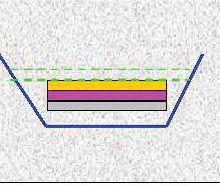(1) Environmental factors
The clean substrate surface is a necessary condition for high-quality transfer, which is the same for any printing process. Before printing, it is necessary to ensure that the substrate is completely exposed. In addition, a clean and tidy working environment is conducive to the transfer of the ink layer tightly adhered to the surface of the substrate. The floating dust in the air is most likely to affect the transfer effect.
(2) Water mark transfer paper activation
The water mark transfer paper is divided into a peelable water mark transfer paper and a dissolved water mark transfer paper, and the graphic of the peelable water mark transfer paper can be separated from the base material after being activated to achieve the transfer; After the transfer paper is activated, the substrate is dissolved in water and the image is in a free state to effect transfer.
Different from the activation of water transfer printing film, watermark transfer paper only dips the transfer paper into water and separates the graphic from the substrate without special solvent. As shown in the figure, the process is simpler.

Water mark transfer paper activation diagram
The specific process is to first cut the water transfer printing paper that needs to be transferred into the required specifications, put it into a clean water tank, and soak it for about 20 seconds to separate the mask from the substrate and prepare it for the transfer.
Water mark transfer paper processing process as shown below, take out the water transfer paper lightly close to the surface of the substrate, scrape the graphic surface with a scraper, so that water extrusion, keep the text flat in the prescribed location, natural drying . For the peelable water mark transfer paper, it is naturally dried and dried in an oven to increase the attachment fastness of the graphic and text, and the drying temperature is about 100°C. Because there is a layer of protective varnish on the surface of the peelable water transfer paper, there is no need to spray protection. However, there is no protective layer on the graphic surface of the soluble water transfer paper, and it needs to be treated with a varnish after being naturally dried. The UV varnish must be cured with a curing machine. When spraying varnish, be sure to prevent dust from falling on the surface, otherwise the appearance of the product will be greatly affected. The control of the coating thickness is achieved by adjusting the viscosity and spray amount of the varnish, and spraying too much can easily cause a decrease in the uniformity. For substrates with larger transfer areas, applying screen printing for glazing to obtain thicker coatings is also a very effective protective measure.

Water mark transfer project
Water transfer printing tips:
1Because helmets and other products surface primer will have different colors, in order to better represent the color of the pattern, generally use white to make a bottom before printing the various colors of ink;
2 ink and gold oil must be adjusted with their respective diluents, the general dilution ratio of 5% ~ 8%;
3 Select different types of gold oil according to the different temperature or climate, and at the same time adjust the degree of hardness and toughness of the film in time according to the situation occurring during the re-post process;
4 In principle, the finished printed product is preferably sealed and the use period does not exceed 6 months.
Source: Coinprint
Brush Egg,Makeup Brush,Cosmetic Brush
Travel Makeup Brush Set Co., Ltd. , http://www.powderpuffmfg.com